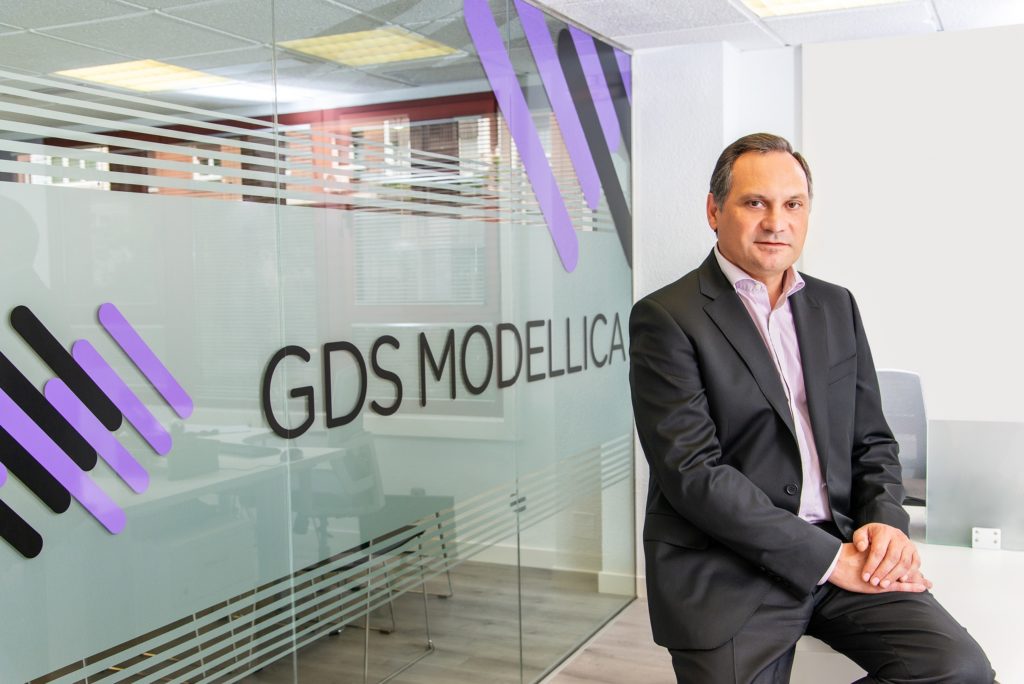1.- You’re the managing director for GDS MODELLICA Europe, Middle East, Asia and Latin America where you’ve had a brilliant career. Can you tell us a little bit about your career and how you got to where you are today?
As an IT engineer, I was always fascinated by the way technology was able to help automate and accelerate decisions in many processes which affect our daily lives. Years ago, this was something that belonged to science fiction, with legendary characters like “Hall 9000” in “2001: A Space Odyssey”, but now, it’s increasingly becoming part of modern life. Today’s technology allows us to gather and analyse an enormous amount of data that holds key information for making decisions that can and do have a big impact on our daily lives.
For example, there are now systems capable of automatically understanding their environment, receiving a flow of data from sensors, combining it with artificial intelligence algorithms and from there, establishing a specific plan of action. Or they can be involved in something more basic, like the millions of authorisations for credit card transactions in the country which are evaluated using intelligent algorithms.
My professional career has revolved around the use of big data and decision-making algorithms and systems which, when used well, can make our daily lives considerably easier. After working for many years for leading multi-nationals in these sectors, I came to GDS Modellica, where through a combination of technology, innovation and vision, I believe that, firstly, we’re achieving great things as leaders in the field, and secondly, we’re really enjoying ourselves, which is doubtlessly another great source of motivation.
As I was saying, technologies like big data or the use of particular decision algorithms make it possible for businesses to be more competitive and profitable by providing a better customer experience, anticipating future needs and, in a certain way, getting ahead of market trends.
GDS Modellica was founded almost two decades ago and is a multi-national company with a presence in more than 36 countries. By starting off by actively listening to the needs of customers, we’ve been able to develop advanced technologies using a set of analytical techniques relating to decision management and the definition of business intelligence. We help businesses to make thousands if not millions of daily decisions in an agile, precise and consistent way and therefore provide their customers with a better user experience through a highly personalised service.
Over that time, we’ve collaborated with hundreds of credit institutions and other organisations, providing “intelligent decision-making solutions” that are adapted to their individual needs and specific markets. We’re talking about decisions like, “Do I approve a loan or credit card?”, “What should the conditions of the loan be?”, “Should I authorise a banking transaction?” or, “What’s the most appropriate offer for this particular customer or business?”
GDS Modellica offers analytics technology for decision-making in sectors like banking, insurance, retail, utilities, telecoms, etc. The aim is to help them provide a personalised service, manage the individual risk of each transaction, combat fraud, comply with regulations, etc. Ultimately, it’s about developing profitable relationships with each one of their customers through the large-scale use of data and algorithms. That’s obviously the first thing. The second thing is to make sure that the decisions those algorithms take, based on machine learning and customisation, are the right ones. To help implement business strategies correctly, our consultants, using their experience with many different customers all over the world, are able to advise on the best market practices and how to implement the logic which is best suited to that organisation and their market.
This decision-making technology can be used on the cloud (DaaS, Decisions as a Service) or on the organisation’s own environment, whether it’s a traditional environment, machine learning environment or a big data environment using traditional algorithms. All the core software is built using market standards, such as Java, webservices, etc. so that any of the company’s solutions can be easily integrated with practically any legacy environment that the user organisation might have.
To be a bit more specific, the company offers decision-making solutions which analyse customer behaviour and other sources of information to be able to do things like predict the likelihood of a purchase, establish how to develop individual marketing campaigns, decide under what conditions to approve credit, assess whether an electronic transaction is fraudulent or not, develop individual strategies to recover a default payment or provide the intelligence to ensure compliance with strict governmental regulations.
Fraud is evolving at the same pace as technology, so innovation is key for keeping ahead of fraudsters. Risk management is currently changing at a dizzying pace as a result of the paradigm shift in the granting of credit, with a strong tendency towards personalised services, digitalisation and multi-channel operations. In such an environment, think about how theft and data filtering can give cyber-criminals easier access to personal information and later steal real identities or create virtual ones. This new economy involves less personal interaction, which allows scammers to hide behind stolen or fake identities. It makes it easier to open accounts and access money, property and services that they don’t have the intention of paying for. Applications for credit using fake identities has led to a rise in non-payments for some very important banking organisations, and this has also been made worse by “internal fraud”.
GDS Modellica offers intelligent solutions which help combat fraud by using algorithms based on the latest machine learning and decision-making technology. Combined with a range of data sources, such as digital validation, social media footprints, the deep web, credit information, etc., these allow organisations to detect and avoid a large part of this fraud.
With regard to regulations, standards like IFRS, capital requirements, etc. have generated an additional workload for businesses, but some have learned how to turn them into a competitive advantage with positive impacts on their bottom line. Within the company, we wanted to help simplify these processes with technology that allows the implementation of complex logic models in highly customisable environments which are easy to manage and validate. These solutions allow an organisation to carry out large volumes of calculations, simulate scenarios, etc. whilst complying with the regulations and thereby create competitive advantages through the efficient use of capital resources.
5.- Tell us about the technologies you use and what you use them for.
All GDS Modellica solutions are based on our own technology and have been developed according to three basic principles: solutions made to be used by end-users who are not necessarily technology-savvy people; solutions which can be incorporated in any end-user environment; and powerful scalable solutions which can provide the necessary functionalities to assure that the logic being applied is correct. This technology forms the foundation of the solutions that GDS Modellica offers and includes core software components such as:
– Decision Management: GDS Modellica has one of the most advanced decision architectures on the market which can be executed in classic or machine learning environments. This architecture can be executed both as on-premises software, such as in traditional environments on the cloud (Windows, Linux, Unix, etc.) or big data environments (Spark, Flink, etc.). Various tests and trials have been carried out showing that it is one of the fastest options on the market and has more powerful functionalities.
– Data Management: GDS Modellica uses DataView, one of the data suites with the most connectors at a global level. We have connectors to more than 350 data sources around the world (Credit bureaus, ID Verification, AML, etc.). This technology enables it to connect to any customer data source to incorporate this information into the decision-making process.
– Advanced Analytics: GDS Modellica has a range of available technologies so that it can benefit from the most advanced analytics technologies, such as artificial intelligence or machine learning. This means that it’s possible to execute models based on R or Python either natively or through PMML. We also use web-based decision intelligence which allows any analytical model to be monitored and tracked in a powerful yet simple way or with solutions like OMLT, a tool which allows us to carry out dynamic training for machine learning models.
– Workflow Management: GDS Modellica’s Case Center technology provides our customers with a user-friendly, graphical way to manage workflows, screens or work queues for processes like procurement, fraud, debt recovery, etc.
GDS Modellica has a global reach across multiple sectors, and although its main focus is on financial organisations like banks, consumer finance and fintechs, we also work regularly with sectors like insurance, utilities and telecoms, amongst others. Ultimately, it’s about implementing decision management technology in those industries where there are clear benefits for their value stream.
At GDS Modellica, we can clearly see that increasingly more companies across multiple sectors need increasingly more business intelligence in their processes with the aim of, amongst other things, bridging the digital gap and connecting with the new generations that are already there. Here in Spain, our customers include three of the country’s main banking groups as well as large gas, electricity and distribution companies.
Decision as a Service (DaaS) is a concept that GDS Modellica has been promoting on the market for years which allows our customers to manage decisions as a service, through a single API, without having to make huge expenditures on implementation projects or buying licences. DaaS is a way of democratising this type of technology, which just a few years ago only within the reach of large companies. With this format, it is possible for almost any company to take advantage of intelligent decision management in their value stream, based on their specific strategy and only paying for what they really need and use.
With this service, customers have flexible real-time access to data sources, analytical models, decision-making algorithms, etc. It changes the approach for implementing solutions to one which is more focused on use on the cloud. From a functional point of view, the benefits are the same as if the customer had it installed on their own environment. It’s possible to start by implementing a limited level of intelligence at a certain stage of the customer cycle (for example, admission) and then later add features and functionalities as we expand through the rest of the business process’ value cycle.
Regarding privacy and performance, based on the best practices and international regulations, this type of service offers multiple layers of physical and logical security, such as an entire architecture dedicated to disaster recovery.
Banking organisations are currently in constant evolution as they try to both adopt the levels of innovation that customers expect and adapt to changing market regulations and the post-crisis era. The sector has increasingly less to do with the traditional model where any administrative task had to be done at a branch during specific hours. Instead, a different business model is being adopted which puts the customer at the centre of the structure of services and products in a multi-channel environment which is available 24 hours a day, seven days a week.
This new era requires in-depth knowledge about customers and, to do this, companies need to compile and process information and segment, identify and anticipate needs.
Open banking aims to help banks implement this new model efficiently and, at the same time, it allows individuals to have greater control over their financial data, which they can freely share with third parties.
Banks possess very valuable customer information, and this new scenario obliges them to share it with whomever the customer chooses and authorises. Similarly, these third parties can provide additional services as long as they’re organisations that fall under the regulator’s jurisdiction. It also allows financial organisations to access banking data from other organisations, tapping into very valuable information from multiple internal evaluation and decision-making processes. In practice, this means that, for example, if you want to buy a car, the salesman can offer you the best possible finance deal there and then because they now have access to your banking information and can use it in an automated decision-making process.
At GDS Modellica, we simplify access to this data and how it is utilised by taking this information and creating libraries of indicators and variables that could be directly used to create analytical and decision-making models for use in the credit cycle. By generating multiple indicators and using the right algorithms, we can make it easier for financial organisations to minimise credit risks and fraud whilst notably improving the customer experience.
This pandemic is going to have an impact on credit organisations both in terms of their bottom line and their own resources. With the situation changing every day, it’s very difficult to gauge the severity of this crisis. But one thing that is certain is that digital channels are going to come out stronger, and this will doubtlessly drive open banking, although it’s important that the PSD2 regulations are fully implemented and effective, which presently isn’t the case.
Companies will start to put the user instead of the product at the centre of the organisation. Today, the majority of users already expect access to their financial services in a matter of seconds from multiple devices instead of having to go to the nearest branch. Artificial intelligence and natural language processing algorithms will both help to provide an increasingly personalised service.
This will allow banks – which until now has had a more superficial knowledge of their customers and played a more reactive role – to understand their users’ habits and provide offer a more personalised offer based on their actual tastes, like what Amazon or Apple have been doing for a while but applied to the financial sector.
The Payment Services Directive, PSD2, increases consumer confidence by strengthening fraud prevention measures whilst at the same time as providing users with access to more suitable, innovative and profitable solutions. This new regulatory framework provides many advantages for the consumer like greater transparency and more information, such as the cost associated with each transaction, transaction status, timeframes, etc. and all this with no added cost. Furthermore, it establishes a limitation of responsibility and encourages the implementation of strong authentication measures.
Organisations will be able to simplify their daily operations and provide their customers with a much more satisfactory user experience by implementing the appropriate technology and intelligence. As I’ve already mentioned, GDS Modellica provides decision-making solutions and machine learning technology that use multiple data sources and enable companies to combat fraud and build profitable relationships between all parties involved.
11.- If I were a business, how could you help me, what can you offer me and why should I choose you?
The data shows that the current trend among younger generations is a preference for interacting with organisations either online or using their mobile phone, through apps, social media, etc. If companies are able to see digitalisation and decision-making based on data analysis as a basic part of their business, they will begin to better understand this new landscape. However, if they continue to see intelligence in business processes as an expense or a secondary tool, they will probably regret it in the near future.
The use of big data tools and artificial intelligence creates great opportunities and benefits which can improve business processes. But it also creates benefits for the customer, who sees improvements in cybersecurity and fraud prevention and will be more satisfied with products and services which are increasingly more in line with their actual needs.
The use of big data tools and artificial intelligence creates great opportunities and benefits which can improve business processes. But it also creates benefits for the customer, who sees improvements in cybersecurity and fraud prevention and will be more satisfied with products and services which are increasingly more in line with their actual needs.
GDS Modellica provides this know-how. We provide the algorithms and best possible practices to deploy intelligence which learns from experience. It’s up to the organisation to define where it wants to go and how this strategy should be adapted to its business objectives. We then provide the technology and the best practices to help implement it. We have the necessary technology and knowledge to support decision-making processes for all of an organisation’s products and services and deliver an omnichannel experience which stands out to the final customer. These decisions can range from the online approval of a new card in a matter of minutes to assessing a debt consolidation loan using a smartphone, tablet, computer, etc.
Digitalisation and the incorporation of intelligence in business processes are being driven by current circumstances, a desire to improve the customer experience and advances in technology.
One of GDS Modellica’s great strengths and the reason our customers choose us is that we know how to adapt our solutions to the needs of the market. We know how to listen and put our best efforts into addressing the customer’s needs. Our technologies have to be adapted to the changing needs of the customer, and innovation is a fundamental part of that strategy that enables us to be prepared for that constant change. It’s an aim which we vow to renew at the start of every year.
Properly understood non-conformism is part of our DNA, and this means that we will continue to provide novel solutions which combine the latest technology with the latest trends and customers’ true needs to provide a service which stands out against other offers on the market. We’re talking about digitalisation, PSD2, advanced analytics (ML and AI), big data, the cloud and many others.
In 2020, we will continue promoting solutions like digital onboarding, for example, which allows money lending processes to be managed from start to finish through interactive channels. These channels use bots and natural language or what we call “bank transaction analytics”, which allows us to take full advantage of the information that open banking provides.
It’s clear that for years, companies like Google, Amazon, Facebook or Apple have already been expanding their businesses beyond what they originally started from. These companies have already delved into many industries and are now going into the financial product market. One of the fundamental strengths of these companies is the data and intelligent processes they have to help direct their businesses.
Digitalisation and the incorporation of business intelligence are being driven by technological changes, a desire to improve the customer experience and the economic benefits it can bring for businesses.
Besides having a global presence, at GDS Modellica, we define our objectives and strategy as an opportunity to create added value for our customers, and this means we’re talking about a dynamic process so we can adapt to these changes and challenges in the market.
It’s important to introduce new innovations to the market whilst considering the time factor, which is a key element for converting ideas into reality.
Our technologies have to be adapted to the customer’s needs, so it’s fundamental for the organisation to have full knowledge of those needs and bear in mind that they are constantly changing.
When we develop our strategy, it needs to include a significant element of innovation so that the company can grow in new areas or abilities.
Innovation is a fundamental part of our strategy, which means being prepared for constant change.
Just as in the analogue environment, the customer is the main focus. Analysing their individual behaviour patterns makes it possible to anticipate and identify their needs, outline appropriate strategies and offer hyper-personalised services. It is more important than ever for companies to learn how to adapt to new ways of engaging and interacting with the customer in order to strengthen their businesses, and being able to count on the correct strategies and analysis will ensure that companies move in a profitable direction.
Businesses, brands and other organisations are all conscious of the value that customers provide through their digital interactions. Each time a consumer interacts digitally with a company, they tell us more about their preferences and attitudes, and this information is valuable in order to learn more about the customer, consolidate the customer relationship, optimise the user experience, and, ultimately, increase sales and customer loyalty. Active listening is a key part of creating, managing and improving the customer’s digital multichannel experience, where the customer is the focal point around which all strategies revolve and the end goal is to increase sales, loyalty and also recommendations.





